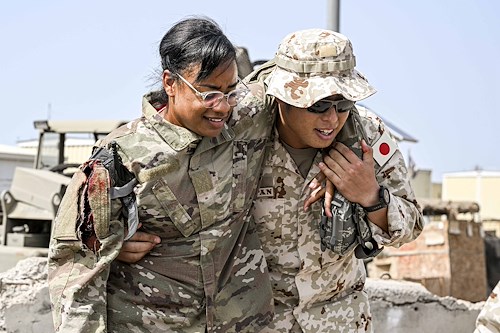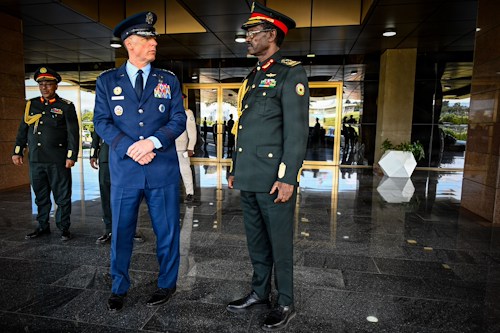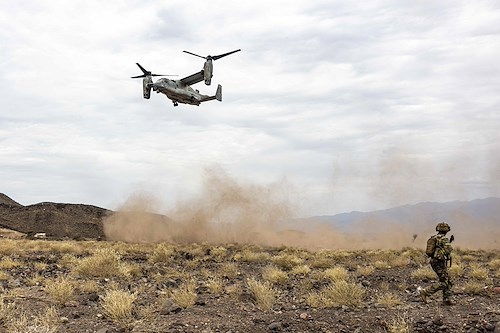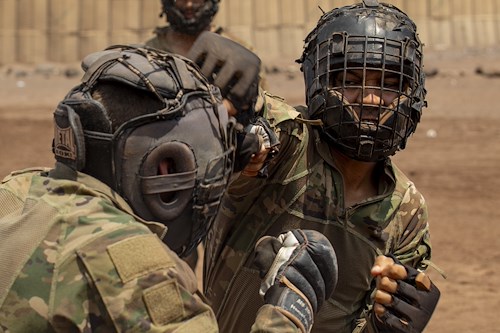Gallery contains 11 images
×
Photo 1 of 11
US, Japan service members train together in casualty combat care
A Japanese Self-Defense Force member simulates assisting a U.S. Soldier during Tactical Combat Casualty Care skills training at Camp Lemonnier, Djibouti, May 29, 2025. The intent of the training was to exchange knowledge about life-saving care in order to reduce combat casualties, increase interoperability between partner forces and strengthen crisis response capabilities. (U.S. Air Force photo by Senior Airman Joseph Bartoszek)
Photo by: Senior Airman Joseph Bartoszek
Photo 2 of 11
US, Japan service members train together in casualty combat care
A member of the Japanese Self-Defense Force practices Tactical Casualty Combat Care tactics while at the Combined Joint Task Force - Horn of Africa Surgeon Cell at Camp Lemonnier, Djibouti, May 29, 2025. CJTF-HOA seeks to collaborate with allies and partners throughout the continent, building mutually beneficial relationships, which help to advance mutual interests. (U.S. Air Force photo by Senior Airman Joseph Bartoszek)
Photo by: Senior Airman Joseph Bartoszek
Photo 3 of 11
US, Japan service members train together in casualty combat care
U.S. Army Sgt. Brandon Hawk, CJTF-HOA Surgeon Cell medical operations noncommissioned officer in charge, practices Tactical Casualty Combat Care skills with a member of the Japanese Self-Defense Force at Camp Lemonnier, Djibouti, May 29, 2025. TCCC training is a Department of Defense training requirement which teaches life-saving first-aid skills to keep a casualty alive until they can be transported to a higher level of care. (U.S. Air Force photo by Senior Airman Joseph Bartoszek)
Photo by: Senior Airman Joseph Bartoszek
Photo 4 of 11
US, Japan service members train together in casualty combat care
A member of the Japanese Self-Defense Force practices Tactical Casualty Combat Care tactics with a U.S. Army service member assigned to the Combined Joint Task Force - Horn of Africa Surgeon Cell at Camp Lemonnier, Djibouti, May 29, 2025. CJTF-HOA seeks to collaborate with allies and partners throughout the continent, building mutually beneficial relationships, which help to advance mutual interests. (U.S. Air Force photo by Senior Airman Joseph Bartoszek)
Photo by: Senior Airman Joseph Bartoszek
Photo 5 of 11
US, Japan service members train together in casualty combat care
U.S. Army Maj. Ryan Kelly, 10th Expeditionary Aeromedical Evacuation Flight Operating Location Horn of Africa officer in charge, demonstrates Tactical Combat Casualty Care tactics during a joint training session with the Japanese Self-Defense Force at Camp Lemonnier, Djibouti, May 29, 2025. TCCC training is a Department of Defense training requirement which teaches life-saving first-aid skills to keep a casualty alive until they can be transported to a higher level of care. (U.S. Air Force photo by Senior Airman Joseph Bartoszek)
Photo by: Senior Airman Joseph Bartoszek
Photo 6 of 11
US, Japan service members train together in casualty combat care
Members of the Japanese Self-Defense Force practice Tactical Casualty Combat Care tactics with U.S. Army members assigned to the Combined Joint Task Force - Horn of Africa Surgeon Cell at Camp Lemonnier, Djibouti, May 29, 2025. CJTF-HOA seeks to collaborate with allies and partners throughout the continent, building mutually beneficial relationships, which help to advance mutual interests. (U.S. Air Force photo by Senior Airman Joseph Bartoszek)
Photo by: Senior Airman Joseph Bartoszek
Photo 7 of 11
US, Japan service members train together in casualty combat care
A Japanese Self-Defense Force member simulates performing Tactical Combat Casualty Care skills on a U.S. service member with moulage makeup at Camp Lemonnier, Djibouti, May 29, 2025. The training provided a platform for Combined Joint Task Force - Horn of Africa to collaborate with allies and partners throughout the continent, building mutually beneficial relationships, which help to advance mutual interests. (U.S. Air Force photo by Senior Airman Joseph Bartoszek)
Photo by: Senior Airman Joseph Bartoszek
Photo 8 of 11
US, Japan service members train together in casualty combat care
Members of the Japanese Self-Defense Force listen to a presentation during a joint Tactical Casualty Combat Care training session with U.S. Army service members assigned to the Combined Joint Task Force - Horn of Africa Surgeon Cell at Camp Lemonnier, Djibouti, May 29, 2025. The training provided a platform for CJTF-HOA to collaborate with allies and partners throughout the continent, building mutually beneficial relationships, which help to advance mutual interests. (U.S. Air Force photo by Senior Airman Joseph Bartoszek)
Photo by: Senior Airman Joseph Bartoszek
Photo 9 of 11
US, Japan service members train together in casualty combat care
Members of the Japanese Self-Defense Force train Tactical Casualty Combat Care tactics with U.S. Army service members assigned to the Combined Joint Task Force - Horn of Africa Surgeon Cell at Camp Lemonnier, Djibouti, May 29, 2025. CJTF-HOA seeks to collaborate with allies and partners throughout the continent, building mutually beneficial relationships, which help to advance mutual interests. (U.S. Air Force photo by Senior Airman Joseph Bartoszek)
Photo by: Senior Airman Joseph Bartoszek
Photo 10 of 11
US, Japan service members train together in casualty combat care
Members of Combined Joint Task Force - Horn of Africa and the Japanese Self-Defense Force pose for a group photo following joint Tactical Combat Casualty Care skills training at Camp Lemonnier, Djibouti, May 29, 2025. The intent of the training was to exchange knowledge about life-saving care in order to reduce combat casualties, increase interoperability between partner forces and strengthen crisis response capabilities. (U.S. Air Force photo by Senior Airman Joseph Bartoszek)
Photo by: Senior Airman Joseph Bartoszek
Photo 11 of 11
US, Japan service members train together in casualty combat care
Japanese Self-Defense Force members simulate performing Tactical Combat Casualty Care skills on a U.S. service member with moulage makeup at Camp Lemonnier, Djibouti, May 29, 2025. The intent of the training was to exchange knowledge about life-saving care in order to reduce combat casualties, increase interoperability between partner forces and strengthen crisis response capabilities. (U.S. Air Force photo by Senior Airman Joseph Bartoszek)
Photo by: Senior Airman Joseph Bartoszek
CAMP LEMONNIER, Djibouti – U.S. Soldiers assigned to the Combined Joint Task Force - Horn of Africa Surgeon Cell and members of the Japanese Self-Defense Force came together to exchange Tactical Combat Casualty Care techniques at Camp Lemonnier, Djibouti, May 29.
TCCC training is a Department of Defense training requirement for U.S. service members, which teaches life-saving first-aid skills to keep a casualty alive until they can be transported to a higher level of care.
During the training, U.S. Army and JSDF service members reviewed key TCCC lessons, such as care under fire, tactical field care and tactical evaluation care. They also utilized CJTF-HOA volunteers wearing moulage special effects makeup to create an immersive experience for participants in the training. The U.S. and JSDF forces worked together to triage multiple simulated casualties.
“We went over the three phases of care under fire in a controlled classroom environment,” said U.S. Army Sgt. Brandon Hawk, CJTF-HOA Surgeon Cell medical operations noncommissioned officer in charge. “Then they had their chaotic scenario, where everyone worked together to apply the techniques reviewed in class. Although this was a review of skills, I believe everyone was able to take away something new from this training.”
Sharing TCCC skills with partners, such as the JSDF, is essential to strengthening combined crisis response capabilities and saving lives on and off the battlefield. By training together, U.S. forces and allied partners develop a shared understanding of medical procedures, streamline communication during emergencies and ensure consistency in life-saving care under fire.
“It is important we do this training together, because we standardize the training level to improve our capability as allies to deepen mutual understanding to build and strengthen relationships and interoperability.” said a JSDF foreign liaison officer.
At the end of the training, a bunker scenario was employed, in which course participants had to respond to simulated indirect fire. This immersive exercise provided real-time, hands-on experience, enabling participants to apply their skills under realistic stress conditions.
“The exercise went very well,” said Hawk. “After the controlled classroom portion, we created a chaotic scenario where everyone could apply TCCC techniques in real-time. The goal was to help everyone become more confident in their abilities, as a team.”
This type of bilateral training is critical to enhancing operational readiness across allied forces. By working side-by-side, U.S. and JSDF service members not only sharpen essential combat care skills, but also fosters seamless interoperability in joint mission environments.
“By doing training like this, we continue maintaining a good relationship with the U.S. military,” said the JSDF FLO. “Meeting each other, having face-to-face discussions and training together are essential to establishing and strengthening a good relationship. By knowing each other and trusting in each other, we then know we can stand shoulder to shoulder if and when the time comes.”
Through continued collaboration with allies and partners across the continent, CJTF-HOA remains committed to building mutually beneficial relationships and maximizing joint training opportunities, which enhances multinational readiness and reinforces the collective ability to respond effectively to crises, whenever and wherever they arise.





































